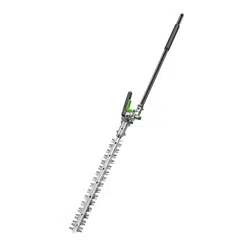Loading ...
Loading ...
Loading ...

HEDGE TRIMMER ATTACHMENT — HTA2000/HTA2000-FC/HTA2020/HTA2020-FC 11
◾
Never allow children to operate the hedge trimmer.
◾
The trimmer shall be used to cut stems less than 1" (26mm) thick.
◾
Trim only in daylight or in good artificial light.
◾
Follow instructions for lubricating and sharpening.
◾
Keep handles dry, clean and free from oil and grease.
ADDITIONAL WARNINGS
◾
Do not charge the battery pack in rain or in wet locations.
◾
The battery pack must be removed from the appliance before it is scrapped.
◾
The battery shall be disposed of safely.
◾
Do not dispose of the battery in a fire. The cells may explode. Check with local
codes for possible special disposal instructions.
◾
Do not open or mutilate the battery. Released electrolyte is corrosive and may
cause damage to the eyes or skin. It may be toxic if swallowed.
CAUTION! The electrolyte is a dilute sulfuric acid that is harmful to the skin and
eyes. It is electrically conductive and corrosive.
◾
Exercise care in handling batteries in order not to short the battery with
conducting materials such as rings, bracelets, and keys. The battery or
conductor may overheat and cause burns.
◾
Replacement Parts - When servicing, use only identical EGO replacement parts.
Use of any other accessory or attachment may increase the risk of injury.
◾
Battery tools do not have to be plugged into an electrical outlet; therefore,
they are always in operating condition. Be aware of possible hazards even
when the tool is not operating. Take care when performing maintenance or
service.
◾
Remove or disconnect the battery pack before servicing, cleaning or
removing material from the hedge trimmer.
◾
Do not wash with a hose; avoid getting water in motor and electrical
connections.
◾
Store the tool in a dry and high or locked location out of reach of children.
◾
Do not expose a battery pack or tool to fire or excessive temperature.
Exposure to fire or temperature above 212 °F (100°C) may cause explosion.
Loading ...
Loading ...
Loading ...
